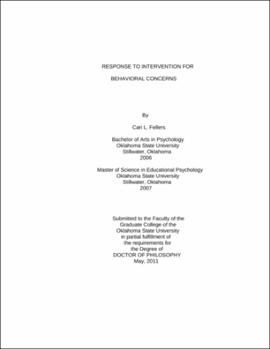| dc.contributor.advisor | Duhon, Gary J. | |
| dc.contributor.author | Fellers, Cari L. | |
| dc.date.accessioned | 2013-11-26T08:34:26Z | |
| dc.date.available | 2013-11-26T08:34:26Z | |
| dc.date.issued | 2011-05 | |
| dc.identifier.uri | https://hdl.handle.net/11244/7391 | |
| dc.description.abstract | In response to the problems surrounding the discrepancy model, IDEA now allows response to intervention (RTI) as an alternative means to identify students with learning disabilities. In research a RTI approach has been extensively applied to SLD and academic concerns, rather than behavior problems. RTI can be applied to behavior, but research needs to be conducted to establish it as an efficient, useful, and conceptually sound approach to diagnosis and treatment of behavior concerns. The purpose of this study was to investigate a RTI model of behavior where in an effective general education intervention was implemented with students in a kindergarten classroom. A model involving increasing intensity was implemented to answer crucial questions regarding RTI. Participants in the first experiment were 19 general education students from an elementary school in a southwest community. The first experiment involved a classwide behavior intervention utilizing prompting and reinforcement for on-task behaviors. The intervention was implemented with an ABAB single case design. After the classwide intervention was deemed effective, 3 non-responding students were identified and targeted for intervention at increased intensities utilizing a multiple baseline design across subjects. Intensity was increased in a systematic, measurable manner until each student reached criterion levels. The second experiment involved the same nonresponding students (n = 3). During this study, the intensity of the intervention was faded in the same increments that it had previously been increased to determine the lowest level of intervention intensity required to maintain student responsiveness. Results of this study indicated that the application of an intervention with increased intensity of reinforcement results in quantitatively more intense intervention for the individual target students. At the conclusion of the intervention phases of the first study, all students were considered to be functioning at the criterion level for success. At the conclusion of the second experiment, all students were maintaining on-task behavior at a tier I intensity of support. This study not only determined which students were in need of increased intensity, but also how much intensity students needed to increase positive behaviors and maintain them across time. | |
| dc.format | application/pdf | |
| dc.language | en_US | |
| dc.rights | Copyright is held by the author who has granted the Oklahoma State University Library the non-exclusive right to share this material in its institutional repository. Contact Digital Library Services at lib-dls@okstate.edu or 405-744-9161 for the permission policy on the use, reproduction or distribution of this material. | |
| dc.title | Response to intervention for behavioral concerns | |
| dc.contributor.committeeMember | Stinnett, Terry | |
| dc.contributor.committeeMember | Poncy, Brian | |
| dc.contributor.committeeMember | Allday, Allan | |
| osu.filename | Fellers_okstate_0664D_11382 | |
| osu.accesstype | Open Access | |
| dc.type.genre | Dissertation | |
| dc.type.material | Text | |
| dc.subject.keywords | behavior | |
| dc.subject.keywords | positive behavior supports | |
| dc.subject.keywords | response to intervention | |
| dc.subject.keywords | special education | |
| thesis.degree.discipline | Teaching and Curriculum Leadership | |
| thesis.degree.grantor | Oklahoma State University | |
